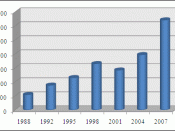The Money Market in Pakistan
Table of Contents
Sr. No. | Title | Page No. |
I. | INTRODUCTION | 1 |
Definition | 1 | |
Primary Market | 1 | |
Secondary Market | 2 | |
Purpose of Money Market | 2 | |
Major Players | 3 | |
II. | MONEY MARKET INSTRUMENTS | 4 |
T-Bills | 4 | |
FIBs | 4 | |
New Government Bonds | 5 | |
TFCs | 5 | |
COIs | 6 | |
WAPDA Bonds | 7 | |
KESC Bonds | 8 | |
III. | TYPES OF TRANSACTIONS | 9 |
Repurchase Agreements | 9 | |
Call | 11 | |
Clean Lending/ Borrowing | 12 | |
Security Lending/ Borrowing | 12 | |
Outright Sale/ Purchase of Government Securities | 13 | |
IV. | OTHER TRANSACTIONS | 15 |
Coupon Washing | 15 | |
Security Parking | 15 | |
Mismatching Transactions | 15 | |
Bond Strategies Based on Implied Forward Rates | 16 | |
V. | REGULATORY FRAMEWORK | 17 |
The State Bank of Pakistan | 17 | |
The Ministry of Finance | 19 | |
VI. | IMPACT OF EXTERNAL FACTORS ON THE MONEY MARKET. | 20 |
SBP Borrowing for Commodity Operations | 20 | |
Year/ Quarter-End Requirements | 21 | |
SBP Borrowing for Budgetary Support | 21 | |
Impact of Foreign Exchange Market | 22 | |
VII. | RISKS INVOLVED IN MONEY MARKET | 23 |
VIII. | BROKERAGE RULES | 24 |
IX. | APPENDIX | 26 |
X | SLR & Discount Rate | 28-29 |
XI | Coupon Washing & Security Parking | 30-31 |
I. INTRODUCTION
Definition
The money market is a wholesale market for low risk, highly liquid, short-term� & long term debt instruments. It serves as an avenue through which banks and financial institutions can offload their excess liquidity or meet their funding requirements. To the government an organized money market represents a means for it to implement its monetary policies in a more efficient manner. Moreover, it provides it with a liquid market for securities through which it can finance its own borrowing requirements.
Trading in the money market only began in Pakistan in February 1991 with the switchover of the Government from on-tap to auction system. As per the previous system interest rates on T-Bills were fixed at 6% and anyone could buy as...


